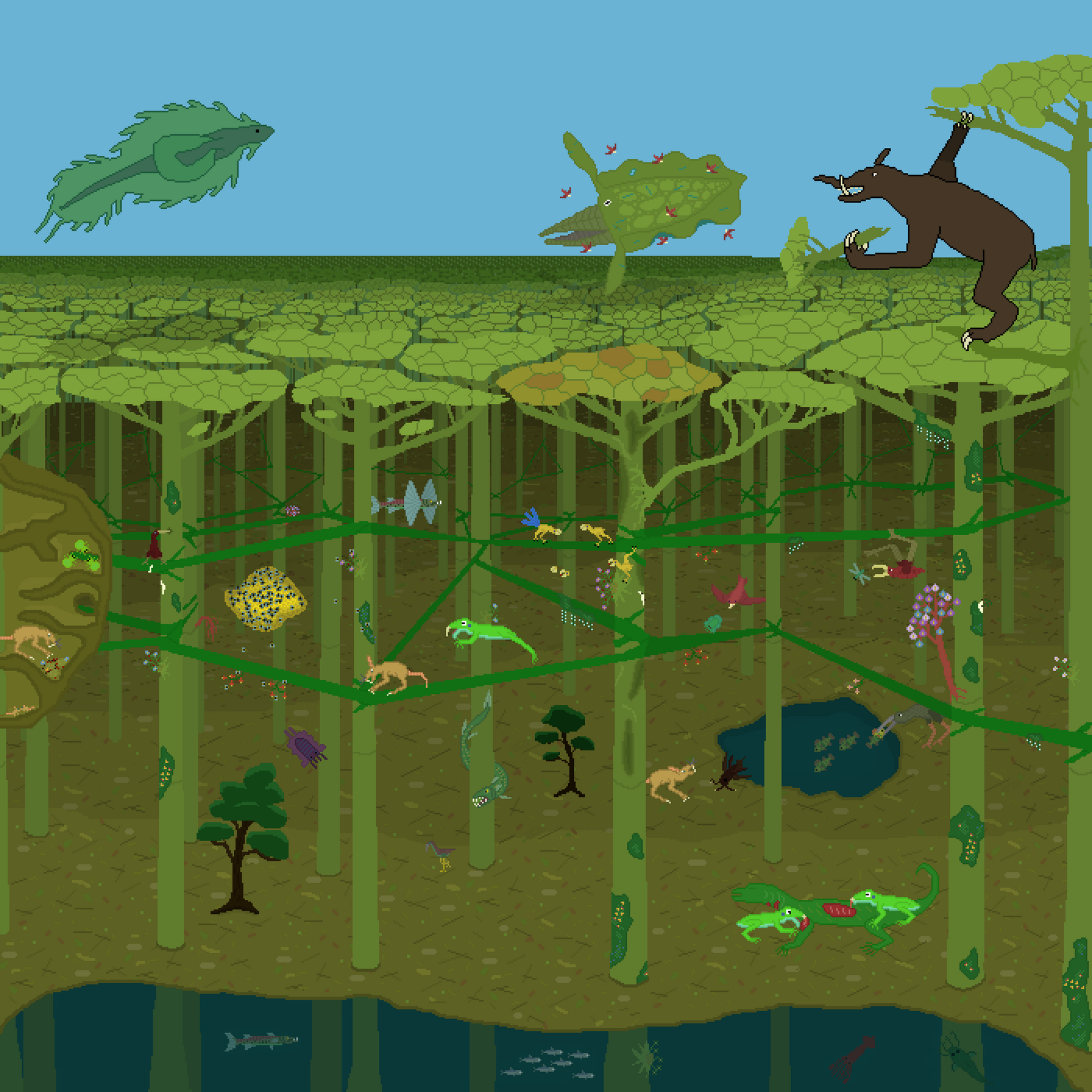HOME | DD
 AyzekKlark — Tiandi,chapter 5: Zero
AyzekKlark — Tiandi,chapter 5: Zero

#bee #bird #frog #mice #pig #squid #tree #animals #creaturedesign #sciencefiction #scifi #sheep #spacestation #treeslandscape #creatureconcept #speculativeevolution #spacehabitat #specbio #speculativebiology #speculativezoology #specevo #alteevo
Published: 2022-01-15 13:23:45 +0000 UTC; Views: 2706; Favourites: 18; Downloads: 3
Redirect to original
Description
This art is my contribution to Salpfish1’s contest (www.deviantart.com/salpfish1/j… ). I'm melting a bit at the moment, so don't be ashamed to point out strange constructions in the text. And strange part in art."Tiandi stopped. There is no gravity anymore. But life was ready.
Most of the water has been concentrated for millions of years in special parts of the potato forest, inside which fish, invertebrates and amphibians have found their home, the soil is fixed thanks to their root systems. The treetops feed thousands of species of birds, amphibians and rodents. It seems Tiandi has a great future.
Let's change the traditions and start with a description of the flora, because everything we see in front of us depends entirely on potato trees. To begin with, their growth never stops, each plant from the solar caste strives to grow to the edge of the habitat. In the process, numerous lianas and other Epiphyte plants appear on them. The accumulation of biomass leads to the gradual closure of gaps between trees, the creation of new undergrowth. But what happens to the past undergrowth? As soon as the tops of the trees move away from them by a sufficient distance, the lower parts of the plant begin to absorb the surrounding water, soil and humus and transport them to the new undergrowth and water storage facilities. If we look at this structure from the other side, we will see only the emptying hard shell of the water bubble and the drying roots.
Bubbles, the level that evolved from catchments, has become a haven for many species of both marine and river animals, for example barracuda, catfish and squid. But in some places there are gaps in the undergrowth through which some animals can fish (such as a two-meter descendant of a Crow Fisherman on the right).
But some fish also come out into the air, such as a Burgundy Spiked Catfish (to the right of the reservoir), trying to scare off a Climbing Beaver, a descendant of mice.In addition to fish and shellfish periodically emerging from the water, there are those who spend their whole lives on land, such as a Snake Barracuda (center, on a tree near the undergrowth) ready to attack a meter-long Crow-Sandpiper.
Another Barracuda, a Sailboat is preparing to attack a group of seed-eating Brachiation birds, too keen on mating rituals using a bright tail. As soon as the Sailboat gets close enough, it will wave its huge fins and overtake the prey in a fraction of seconds.To their right, a predatory Brachiation Crow hangs on a vine ready to grab a dragonfly with one of its paws, which differs from their usual way of hunting - a sharp extension of the limbs to jerk the beak towards the prey.
Below these birds, a Jet Spear flies between the trees in pursuit of a Cuttlefish Butterfly. Jet Spear is a descendant of flying squid using jet propulsion to accelerate. Their fins have lengthened and strengthened for better maneuvering, and there is an elongated dagger beak for capturing prey.
But the space under the leaves is not the native environment of Jet Spear. They spend most of their lives in flocks, looking for large prey in the sky - filtrates and photosynthetic. The first include such giants as the Squid Whale (top, center), which adapted its beak to catch plankton. He is surrounded by a pack of Jet Spears, causing many cuts and forcing him to fall into trees. To their left floats a large descendant of newt, a Water Lily. The ancient symbiosis with algae has reached its maximum, turning the Newt Lily into a living leaf looking for water.
An Elephant Branch looks at all this from a large potato tree. This descendant of the water pig, the last of the farm animals on Tiandi (marine forms became extinct with the draining of the ocean), the size of an African elephant spends his entire life eating potato trees and occasionally attacking Stray Beehives (yellow dot on the left). These bees began to move their hive to the flowers by the common effort of the colony.
To the left of the Hive, a nest of Climbing Beavers is attached to a tree, which has been seen for three generations. The fourth generation crawls in the lower chamber, above them their father inspects food supplies - berries, seeds, flowers and ungrown potatoes. In the uppermost chamber of the nest, at the point of contact with the vine, several Water Aphids have stuck, the safest source of water for Climbing Beavers. But what kind of dangers prevent them from walking a couple of dozen meters?
In the early Glenocene, the top predators were flightless birds, similar to the terror of the birds of the earth. But when the potato forests began to hold back water and block the sun, the first ones who climbed to the top were not them, but ... frogs. Feeling perfect in shallow waters occupying a whole tier of the forest, they began to rapidly increase in size and by the time the birds came up, they became swift and deadly predators. Their descendant, the Frog Beak (center of the screen, bottom right), is a human-sized death machine with a sharp outgrowth on the upper jaw, with which it kills its prey."






















